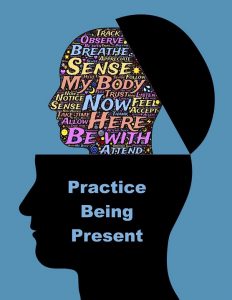I recently heard a TEDx WashingtonSquare talk presented by Dr. Shauna Shapiro, called The Power of Mindfulness: What You Practice Grows Stronger. Dr. Shapiro is a professor and scientist who has studied how people change and transform. She has discovered that one of the most effective vehicles for change is mindfulness – paying attention in the present moment.
Dr. Shapiro’s talk gave me pause to consider the power of mindfulness, based on conclusions she has drawn from modern neuroscience and ancient wisdom. Keep reading to learn how a mindfulness practice can help you make positive changes in your brain and in your life.
Mindlessness
 Did you know that our minds wander 47% of the time? That’s almost half of our lives that we’re not living in the present moment.
Did you know that our minds wander 47% of the time? That’s almost half of our lives that we’re not living in the present moment.
When we’re in “mindless” mode, our attention feels hopelessly scattered, absorbed in the incessant chatter of the mind and life’s day-to-day annoyances. Life can quickly pass us by when we’re not focused on what’s most important.
In addition, many of us have learned to emphasize the negative and overlook the positive things in our lives. When we’re in mindless mode, we miss the big picture – the miracle of life itself and the many daily blessings we tend to take for granted.
What is Mindfulness?

Mindfulness is the practice of being fully aware of the present moment and your thoughts, without casting judgment or trying to qualify those thoughts as “positive” or “negative.” Mindfulness is a state of active, open attention on the present.
Mindfulness is a conscious awareness of your thoughts and the impact they have on you, so you can release the thoughts that aren’t serving you and replace them with thoughts that will help you get the results you want. Your thoughts create your reality, so when you change your thinking, you also transform the way you experience the world around you.
Mindfulness can be a healthy way to identify and manage hidden emotions that may be causing problems in your personal and professional relationships. A mindfulness practice—even for just five minutes a day—can help you to become more aware of your thoughts and how they are triggering certain emotions and responses.
Although mindfulness has traditionally been a practice of Eastern spiritualists and Zen Buddhists, the Western medical community has recently embraced the many health benefits of applying these practices to our everyday routine.
Mindfulness is frequently used in meditation and with certain kinds of therapy. It offers many positive benefits, including lowering stress levels, improving overall health, and protecting against depression and anxiety.
A Mindfulness Practice Changes Your Brain
 How does a mindfulness practice work over time? Our repeated experiences literally shape our brains through cortical thickening – the growth of new neuron pathways in the brain — in response to repeated practice.
How does a mindfulness practice work over time? Our repeated experiences literally shape our brains through cortical thickening – the growth of new neuron pathways in the brain — in response to repeated practice.
Researchers speculate that mindfulness-based training offers lasting effects on the way problems are perceived and subsequently dealt with, resulting in more balanced emotional responses. Not only are there measurable changes in the response of the amygdala (part of the limbic system of the brain) to stimuli, but people report a significant and lasting decrease in their depression.
Each of us is growing something every moment, so the question becomes, what do you want to grow? What do you want to practice? Are you focused on what you want, or are you focused on what you don’t want? What you focus on expands. What you practice grows stronger.
Shame Doesn’t Work
 Studies have shown that when we feel shame, the centers of the brain that manage growth and learning shut down and our resources are used for survival. Shame robs the brain of the energy it needs to do the work of changing.
Studies have shown that when we feel shame, the centers of the brain that manage growth and learning shut down and our resources are used for survival. Shame robs the brain of the energy it needs to do the work of changing.
Fears, insecurities and shame about the past can make it difficult to fully enjoy the present. The key to a happier and more fulfilling life is in learning how to pay attention and focus on the present moment. Practicing mindfulness can help you live in the moment, rather than dwelling on the past or anxiously anticipating the future.
Mindfulness is a tool that allows people to be more aware of their physical and emotional conditions without being self-critical and judgmental … to regain control over destructive feelings and thought patterns.
Kindness Works!
Practicing kindness with yourself gives you the courage to look at those parts of yourself that you don’t want to see. It bathes your brain with dopamine — turning on the learning centers of the brain —  which gives you the resources you need to change.
which gives you the resources you need to change.
Dr. Shapiro emphasized in her TEDx talk that true and lasting transformation requires kind attention, even for the seemingly unforgivable parts of ourselves. Those who allow self-judgment, shame and frustration to be part of their meditation practice will find that focusing on these negative things will make them grow stronger.
Mindfulness Takes Practice
Mindfulness requires that we intentionally pay attention with kindness. Transformation is possible for all, and Dr. Shapiro reminds us that it requires kind attention, not shame.  This kind attention takes lots of practice to achieve.
This kind attention takes lots of practice to achieve.
One of Dr. Shapiro’s favorite daily rituals to build kind attention into her life is to look in the mirror each morning and say, “Good morning, Shauna, I love you.” Although this daily practice may feel really uncomfortable at first, she promises that over time it gets easier.
A mindfulness practice is a deliberate form of mental training in which you compassionately and non-judgmentally return to the present when you notice your mind wandering. You can literally sensitize your mind to the preciousness of life — moment by moment — by learning to better focus your attention and intentionally decide where you will place it.
Your Journey to Mindfulness
Here are seven steps to help you begin your journey to mindfulness:
- Make time. Set aside 5-10 minutes every day that you commit to. It’s ideal if this time is the same time every day. If you have young children, it might be best to do this when they’re at school. Set an alarm on your phone to remind you to do your mindfulness practice at the same time each day.
- Find a quiet space. Close the door and put your phone on silent.
- Get comfortable. Sit on a chair, with your back straight and feet on the floor. Let your hands sit comfortably in your lap. Or if you’re more comfortable lying down, find a comfortable surface to lie down on.
- Breathe deeply. Close your eyes and take a few slow, deep breaths. Focus on what your body feels like and notice any distress you feel in your body. As you inhale, imagine yourself sending a ray of warm soothing energy to any parts of your body that feel tension or pain. As you exhale, imagine the tension or pain leaving the body with your breath.
- Take in the present moment as a passive observer. With each breath, become aware of any thoughts that drift through
 your mind. Do your best to remain a passive observer of these thoughts, suspending any judgment. Notice how your thoughts make you feel. Some thoughts make you feel happy, excited, empowered, uplifted, encouraged or energized; other thoughts trigger anxiety, anger, sadness, hopelessness, guilt, embarrassment, or other uncomfortable emotions.
your mind. Do your best to remain a passive observer of these thoughts, suspending any judgment. Notice how your thoughts make you feel. Some thoughts make you feel happy, excited, empowered, uplifted, encouraged or energized; other thoughts trigger anxiety, anger, sadness, hopelessness, guilt, embarrassment, or other uncomfortable emotions.
Now that you are aware of your thoughts, you have the power to choose different thoughts that are empowering and uplifting. Think about the emotions you want to feel right now. Then think about things that make you feel that way. Intrusive thoughts may present themselves the moment you feel as though you’ve managed to clear your mind. Don’t get discouraged! Simply redirect your thoughts to think about the things that make you feel the way you want to feel.
- Feel the feelings you want to feel. Ground yourself in the present moment as you intentionally focus your attention on what you choose to feel. Enjoy that feeling in the present moment.
- When you’ve finished, have an intention. It can be difficult to transition from this quiet, calm state to the bustle of your everyday life, so create an intention. It can be as simple as, “When I get up, I’ll make a cup of tea.” Throughout the rest of your day, reflect on the sensation of being fully present with the feeling you choose to feel.
If you’d like to explore getting some support and learning strategies to help you live more mindfully, let’s schedule a no-cost, no-pressure Discovery Call today.
Additional Resources
- Free Coloring Pages: Reduce Stress & Increase Joy: 19 Inspirational Coloring Pages
- Free Coloring Book: Relaxing Designs: Mandala Coloring Book with 24 Designs
- Blog: Five Things to Know About Stress and What You Can Do to Manage It
- Blog: Lighten the Load
- Blog: Make a Positive Mental Shift
- Blog: White Space: Why it Matters in Your Life
- Guide: Banish Stress from Your Life: Your Guide to Living More Peacefully
- Guide: Living with Purpose
- Guide: My Gratitude Journal

Life Architect – Creating Blueprints for Purposeful & Productive Lives
Kathy@OrgCoach.net www.OrgCoach.net Follow me on Facebook






Great article, Kathy. I have been thinking about mindfulness a lot lately as I envision my Conscious Conflict Management course. We are following parallel paths! That’s not surprising!
Philip, congratulations on joining the group of us who are Certified Canfield Success Principles Trainers! Glad you liked this article. Mindfulness is certainly something we have learned a lot about through our training with Jack, as well as many other thought leaders. I think a daily mindfulness practice holds the key to many transformational opportunities in our daily lives.
So isn’t the “practice of mindfullness” just you training your subconscious to adapt yet another pattern?
Carla, the way I understand it, practicing mindfulness for even as little as 5 minutess a day offers the opportunity for you to CONSCIOUSLY observe and then choose your thoughts. When you do this daily, over time you will create repeated patterns of thought, which can literally shape your brain by stimulating the growth of new neuron pathways. Although I am not an expert on the brain, my understanding is that we can train our subconscious to adapt that pattern of thought.
Mindfulness involves a conscious awareness of your thoughts and the impact they have on you. There are actually three parts to this: (1) having an awareness of whatever thoughts pop into your head, (2) releasing the thoughts that aren’t serving you well, and (3) replacing them with thoughts that will help you feel the way you choose to feel and attract more of whatever you want into your life.
As Dr. Shapiro says, “what you practice grows stronger,” so if you focus on what you DON’T want, you’ll get more of that. If you focus your thoughts on what you DO want, you’ll get more of that.
Dear Kathy, this is a great subject….We all need it. We might know it, but hard to do it in our daily lives…So these steps you recommend to practice and use daily will be very helpful. Thank you very much for sharing these wonderful blogs with us.
Sheida, you are most welcome! I hope you will set aside 5 minutes a day to do this mindfulness practice. I’d love to hear wht shifts you are experiencing after consistentyly doing it for a couple weeks.